Book Reviews
This page will be devoted to Book Reviews of an eclectic selection of books which will be selected by the reviewer. If you would like to submit a Book Review please feel free to go ahead. The steps are simple. Select a book. Read it. Tell us what you thought about it by submitting a review.
[The library in the parish hall was recently sorted by author’s or editor’s last name, with the exception of shelves on the bottom about comparative religion, and versions of the Bible. Have a look! Read a book! Feel free to write a review for our website.]
The Meaning of Mary Magdalene
Discovering the Woman at the heart of Christianity
By Cynthia Bourgeault Reviewed by Jan Naragon
Discovering the Woman at the heart of Christianity
By Cynthia Bourgeault Reviewed by Jan Naragon

It was not my intention to review this book. I had hoped to find a historical novel, Mary, called Magdalene, by Margaret George, and review it first, mainly because I had already put in the reading time. However, it’s not to be found at St. Barnabas, unless it’s on your bedside table. [San Diego County Library has a copy.]
Nevertheless, I pulled a few books out on Mary Magdalene, and I’m glad to have begun with this one. The author, Cynthia Bourgeault, is an Episcopal priest, scholar, and mystic. She hopes to rebrand MM as truly the “apostle to the apostles,” beginning with the four Gospels that won acceptance into the New Testament, and continuing with three of the so-called Gnostic gospels. The gospels of Thomas and MM shed light on the soul-to-soul relationship between Jesus and MM, and how early the pushback about a woman having dibs on the resurrection story began. MM’s Gospel dates from the time of Gospel of John – very early in the development of Christianity. The author resists the urge to join the legion of purely feminist treatments of MM’s plight. She hopes that MM’s extra-profound understanding of Jesus’ mission will help us get it, too.
On a scale of 1 to 10, where The DaVinci Code is a 1, Margaret George’s novel is a 3, and a theoretically-complete version of MM’s Gospel would be a 10, this book seems to rate about an 8 in its scholarly approach to a difficult subject – that the Son of Humanity would take on a physical relationship with a woman as one of the ways that He “shares our common lot.” Some familiarity with Buddhist goals of practice might be helpful to readers. This book is not going to sit well with those who trust their lives to the apostolic succession as an innately male thing. Bourgeault is well-versed in Near Eastern and Semitic cultures outside of Judaism in the 1st century, and uses their world views to help interpret the “conscious love” relationship between Jesus and MM. The author’s succinct explanation of Jesus’s teachings on emptying oneself and thus aligning with the Invisible realm was a highlight.
I grabbed a couple more books on MM which I don’t intend to read. The Secret Teachings of Mary Magdalene (Nahmad & Bailey) lost me when I looked up its version of MM’s Gospel, and the two missing parts were somehow there, even though this book was written four years prior to Bourgeault’s. Apparently one of the authors had a vision of MM, who dictated the missing parts to her. Oy vey. Not much evidence of research, either. Another book, The Magdalene Gospel (Ashcroft), is unsure whether it is fiction or not. It is structured almost like a play about a group of women who were mentioned in the canonical Gospels during the days leading up to the resurrection. Maybe comfier, but mistitled.
I go on a topical binge every now and then – past binges in the past have included King Arthur, Eleanor Roosevelt, and Robert S. McNamara. Maybe I will continue with other books Bourgeault suggests about the puzzle and power of Mary Magdalene. Maybe I will even move on to Nadia Bolz-Weber!
(Jan Naragon)
Nevertheless, I pulled a few books out on Mary Magdalene, and I’m glad to have begun with this one. The author, Cynthia Bourgeault, is an Episcopal priest, scholar, and mystic. She hopes to rebrand MM as truly the “apostle to the apostles,” beginning with the four Gospels that won acceptance into the New Testament, and continuing with three of the so-called Gnostic gospels. The gospels of Thomas and MM shed light on the soul-to-soul relationship between Jesus and MM, and how early the pushback about a woman having dibs on the resurrection story began. MM’s Gospel dates from the time of Gospel of John – very early in the development of Christianity. The author resists the urge to join the legion of purely feminist treatments of MM’s plight. She hopes that MM’s extra-profound understanding of Jesus’ mission will help us get it, too.
On a scale of 1 to 10, where The DaVinci Code is a 1, Margaret George’s novel is a 3, and a theoretically-complete version of MM’s Gospel would be a 10, this book seems to rate about an 8 in its scholarly approach to a difficult subject – that the Son of Humanity would take on a physical relationship with a woman as one of the ways that He “shares our common lot.” Some familiarity with Buddhist goals of practice might be helpful to readers. This book is not going to sit well with those who trust their lives to the apostolic succession as an innately male thing. Bourgeault is well-versed in Near Eastern and Semitic cultures outside of Judaism in the 1st century, and uses their world views to help interpret the “conscious love” relationship between Jesus and MM. The author’s succinct explanation of Jesus’s teachings on emptying oneself and thus aligning with the Invisible realm was a highlight.
I grabbed a couple more books on MM which I don’t intend to read. The Secret Teachings of Mary Magdalene (Nahmad & Bailey) lost me when I looked up its version of MM’s Gospel, and the two missing parts were somehow there, even though this book was written four years prior to Bourgeault’s. Apparently one of the authors had a vision of MM, who dictated the missing parts to her. Oy vey. Not much evidence of research, either. Another book, The Magdalene Gospel (Ashcroft), is unsure whether it is fiction or not. It is structured almost like a play about a group of women who were mentioned in the canonical Gospels during the days leading up to the resurrection. Maybe comfier, but mistitled.
I go on a topical binge every now and then – past binges in the past have included King Arthur, Eleanor Roosevelt, and Robert S. McNamara. Maybe I will continue with other books Bourgeault suggests about the puzzle and power of Mary Magdalene. Maybe I will even move on to Nadia Bolz-Weber!
(Jan Naragon)

